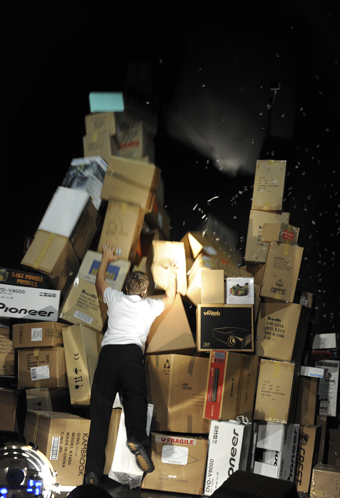a theatre for children other to itself
bryoni trezise: jack and the beanstalk: a musical fairytale

Sam Routledge, Jack & the Beanstallk
photo Heidrun Löhr
Sam Routledge, Jack & the Beanstallk
JACK AND THE BEANSTALK: A MUSICAL FAIRYTALE IS THE SECOND STAGE OF CHIARA GUIDI’S DEVELOPMENT OF THEATRE FOR CHILDREN AT CAMPBELLTOWN ARTS CENTRE. AS CO-FOUNDER, WITH ROMEO CASTELLUCCI, OF HIGH PROFILE ITALIAN THEATRE COMPANY SOCÌETAS RAFFAELLO SANZIO, GUIDI SPOKE AT THE CENTRE IN 2010 OF HER AIMS TO CONSTRUCT A “CHILDHOOD OF THEATRE” WHICH INCORPORATED THE GENIUS OF YOUTH IN A “REVERSE PEDAGOGY.”
Children can see through the senses, she explained, and thereby have access to imagination before reality impinges (RT100, p32). Listening to Guidi speak in 2010, and watching her work in a process-driven masterclass of unfolding surprises, I was struck by her intense harnessing of the life of childhood to inform a theatre of self-conscious story-ing: objects uncannily entered the space only to depart moments later; characters were suddenly bigger or smaller or absent; there was darkness and fear, but jokes and laughter too. In this workshop, children were narrative subjects, participants and teachers, leading adult performance makers on a journey into the ‘forgottenness’ of creativity.
Jack and the Beanstalk shifts Guidi’s collaboration with Campbelltown Arts Centre to a more traditional phase. This time, adults make a work for children to watch. The darkness of her 2010 workshop has been maintained, as have its fear associations, but the open participatory space has been drawn into a more static, seated set-up. We enter to an empty stage flanked by musicians, the mood already tense. The performers begin percussive spatterings of cymbal, drum and high-pitched, atonal “Jacks.” The sound is anarchic and urgent, if in a slightly aged, experimental way. Jack (Sam Routledge) is the object of our concern with the frenzied noise around him making for an ominous start to a story that most in the audience know well. Jack trades a cow for magic beans; the beans grow a giant stalk which he climbs, enabling him to steal gold, a gold-laying goose and a harp from an ogre who guards them in the sky. Jack thrice faces his fears and is rewarded by claiming the wares as his own and shafting the ogre into to the heavens for good by cutting down the stalk.
As with many fairytales, the pathos of Jack and the Beanstalk is underwritten by a number of narrative discomforts which fail to historically translate: Jack is a protagonist whose stealing we applaud and he repeatedly steals without warrant (it seems). He is greedy and devious (it seems) and yet we are on his side. None of this particularly matters, except that it becomes a blind spot the work-in-progress does not seem interested in tackling. Beyond animating a context in which children can safely live out fear, the work doesn’t really explain why Jack does what he does. Why this story of greedy heroics? Why here? Why now?
What is clear is that the tale has been used to foreground a dramaturgy of imagination. In this, terror and dread are summoned by way of narrative suggestion; little happens visually in the space but the sonic environment is full. The performers’ actions are presentational; they work ball games, task-based actions and text across a stage which refuses to visualise the gruesome ogre or his heavens. Instead, we hear the doomful clanking of his tableware and imagine the children he’s yearning to munch. The narrator (Katia Molino) does a good job of enticing us into this world of fear. Volunteers are selected to accompany Jack to the ogre’s house behind the curtains and some are visibly scared, raising their hands only to turn back. I asked one young boy after the show what the ogre’s house was like: “Great,” he said, “I got to help them with their sound effects, banging plates and cups and things.”
Guidi and her Australian collaborators had a challenging, mere two weeks in which to get to know each other to develop this showing. As a work-in-progress, the theatrical tension sustained between visible and invisible, material and imagined is meaningfully crafted. There were moments when theatre got carried away with its own imagination, rupturing the diffusely non-representational space —including the entry of a glorious golden egg-laying goose, in life-sized puppet form, animated to flex and preen and nestle at the foot of the stage to be caressed at the close of the work.
Guidi’s enmeshment of the invisible world of the story with the aural world of the musicians marks the work’s clear departure from typical children’s theatre, replete as it usually is with playful colour and scenography. What remains to unfold, however, is to imagine into imagination which is what Chiara Guidi has so passionately called for. The final work will premiere at Campbelltown Arts Centre in 2013. For this, I’m counting on seeing a theatre for children which is other to itself altogether. This is no small ask, but having observed this project from the outset, it lingers as a tantalising promise nonetheless.
Jack and the Beanstalk: A Musical Fairytale, director Chiara Guidi, facilitator Jeff Stein, performers Drew Fairly, Christa Hughes, Katia Molino, Sam Routledge, Annette Tesoriero, musicians Robbie Avenaim, Jim Denley, Veren Grigorov, Paul Prestipino, Laura Tanata, design and puppetry Scott Wright, lighting Clytie Smith, producer Annemarie Dalziel; Campelltown Arts Centre NSW, Feb 17-19
RealTime issue #108 April-May 2012 pg. 29






